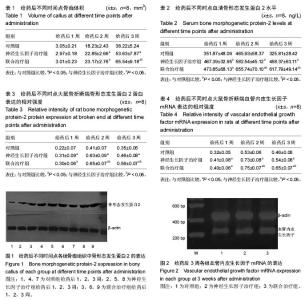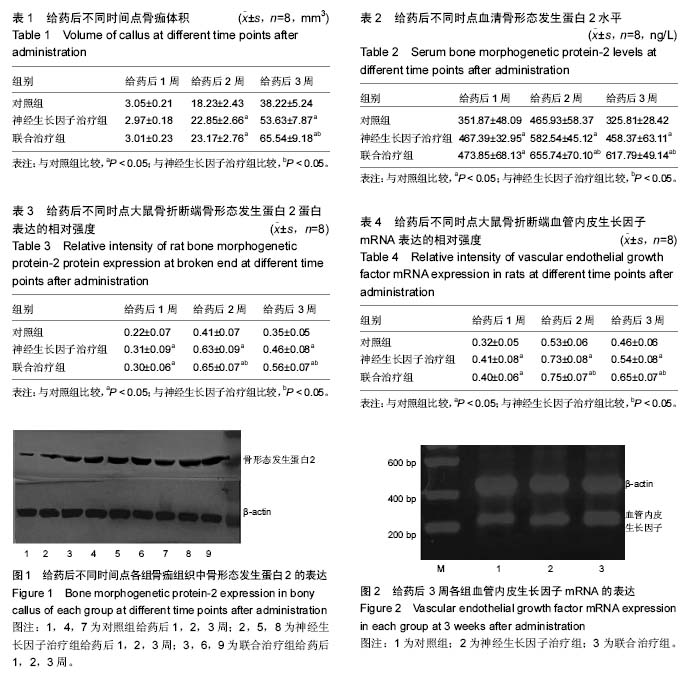| [1] Zhuang YF, Li J. Serum EGF and NGF levels of patients with brain injury and limb fracture. Asian Pac J Trop Med. 2013;6(5):383-386.
[2] Giannoudis PV, Mushtaq S, Harwood P, et al. Accelerated bone healing and excessive callus formation in patients with femoral fracture and head injury. Injury. 2006;37 Suppl 3:S18-24.
[3] Stefani CM, Machado MA, Sallum EA, et al. Platelet-derived growth factor/insulin-like growth factor-1 combination and bone regeneration around implants placed into extraction sockets: a histometric study in dogs. Implant Dent. 2000;9(2):126-131.
[4] 邓江,黄文良,阮世强,等.胰岛素样生长因子-Ⅰ活化组织工程骨修复骨缺损的实验研究[J].第三军医大学学报, 2011, 33(2):145-147.
[5] 姚建华,李亚非.神经生长因子对骨折愈合影响的研究进展[J].中国矫形外科杂志,2000,7(10):996-998.
[6] Roberts JL, Moreau R. Emerging role of alpha-lipoic acid in the prevention and treatment of bone loss. Nutr Rev. 2015;73(2):116-125.
[7] Polat B, Halici Z, Cadirci E, et al. The effect of alpha-lipoic acid in ovariectomy and inflammation- mediated osteoporosis on the skeletal status of rat bone. Eur J Pharmacol. 2013;718(1-3):469-474.
[8] 刘冠华,张柳,梁春雨.脑损伤合并骨折可加速骨折愈合及异位骨化[J].中国组织工程研究,2012,16(46):8721-8726.
[9] Morley J, Marsh S, Drakoulakis E, et al. Does traumatic brain injury result in accelerated fracture healing. Injury. 2005;36(3):363-368.
[10] 杨森,王海龙,盛伟斌,等.骨折合并脊髓损伤患者血清中转化生长因子β1变化:有利于促进骨折愈合[J].中国组织工程研究,2015,19(2):165-169.
[11] Bidner SM, Rubins IM, Desjardins JV, et al. Evidence for a humoral mechanism for enhanced osteogenesis after head injury. J Bone Joint Surg Am. 1990;72(8):1144-1149.
[12] 王林.合并中枢神经损伤骨折愈合过程中胰岛素样生长因子Ⅰ的作用[J].中国组织工程研究与临床康复,2011, 15(33):6168-6171.
[13] 郑少涛,林喜容,周少鹏.脑外伤合并骨折患者血清胰岛素生长因子Ⅱ水平的变化[J].中国现代医生,2014,52(2):19-23.
[14] Zhuang YF, Li J. Serum EGF and NGF levels of patients with brain injury and limb fracture. Asian Pac J Trop Med. 2013;6(5):383-386.
[15] 怀文娟,韩晓峰,朱颖华.经皮局部注射神经生长因子对骨折愈合的影响[J].中国药业,2015,34(12):41-42.
[16] Jehan F, Naveilhan P, Neveu I, et al. Regulation of NGF, BDNF and LNGFR gene expression in ROS 17/2.8 cells. Mol Cell Endocrinol. 1996;116(2):149-156.
[17] 刘振刚,刘宇鹏,李放,等.神经生长因子在骨折愈合中的作用[J].中国医药指南,2013,11(4):491-493.
[18] 赵重熙,马军,何宁,等.局部应用神经生长因子对周围神经损伤后骨折早期愈合的影响[J].中国组织工程研究,2015, 19(15):2320-2324.
[19] Mainini G, Rotondi M, Di Nola K, et al. Oral supplementation with antioxidant agents containing alpha lipoic acid: effects on postmenopausal bone mass. Clin Exp Obstet Gynecol. 2012;39(4):489-493.
[20] Fu C, Xu D, Wang CY, et al. Alpha-Lipoic Acid Promotes Osteoblastic Formation in H2O2 -Treated MC3T3-E1 Cells and Prevents Bone Loss in Ovariectomized Rats. J Cell Physiol. 2015;230(9):2184-2201.
[21] Aydin A, Halici Z, Akoz A, et al. Treatment with α-lipoic acid enhances the bone healing after femoral fracture model of rats. Naunyn Schmiedebergs Arch Pharmacol. 2014;387(11):1025-1036.
[22] Koh JM, Lee YS, Byun CH, et al. Alpha-lipoic acid suppresses osteoclastogenesis despite increasing the receptor activator of nuclear factor kappaB ligand/osteoprotegerin ratio in human bone marrow stromal cells. J Endocrinol. 2005;185(3):401-413.
[23] Akman S, Canakci V, Kara A, et al. Therapeutic effects of alpha lipoic acid and vitamin C on alveolar bone resorption after experimental periodontitis in rats: a biochemical, histochemical, and stereologic study. J Periodontol. 2013;84(5):666-674.
[24] 叶夏云,罗晓红,戴永利.硫辛酸联合神经生长因子治疗糖尿病周围神经病变的疗效观察[J].军医进修学院学报, 2011,32(12):1226-1277.
[25] 侯波,王毅,沈宇辉.骨形态发生蛋白-2信号通路与骨发生发育及损伤修复[J].中国组织工程研究,2013,17(2): 342-346.
[26] 陈雯辉,王大业,麻松,等.脑外伤后血小板衍生因子及血管内皮生长因子对骨折愈合影响的实验研究[J].首都医科大学学报,2007,29(6):745-752.
[27] Khan AH, Capilla E, Hou JC, et al. Entry of newly synthesized GLUT4 into the insulin-responsive storage compartment is dependent upon both the amino terminus and the large cytoplasmic loop. J Biol Chem. 2004;279(36):37505-37511.
[28] 张孝丽,郭晖.α硫辛酸治疗糖尿病周围神经病变的研究进展[J].医学综述,2011,17(2):281-283.
[29] 刘宇鹏,赵德伟,王卫明,等.神经生长因子可促进骨折愈合过程中血管内皮生长因子的表达[J].中国组织工程研究, 2014,18(24):3863-3869. |

